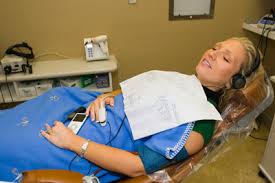Dental anxiety is real, and the truth is it’s quite common to feel uncomfortable. The sounds and smells at the dental office often trigger anxiety. Fortunately, it is manageable, and as dental professionals it is our job to make the patient experience as comfortable as possible. 
At Artistic Dental we have stunning, enlarged photographs of famous canyons and national parks on our ceilings to help transport our patients to another place, to ease their fears to help them relax. We have headphones for those that wish to block the noise. We also try to address our patients fears by discussing the planned procedure; we find this often helps reduce anxiety and lets patients know what to expect.
When these techniques do not do the trick or when a patient is really struggling, we are able to offer sedation dentistry. Sedation dentistry uses medication to help the patient relax. It is sometimes referred to as “sleep dentistry”, but that’s not completely accurate. Patients are usually awake with the exception of those under general anesthetic.
The levels of sedation used include:
- Minimal sedation: the patient is awake but relaxed
- Moderation sedation, formerly referred to as conscious sedation: the patient may slur their words when speaking and not have much memory of the procedure
- Deep sedation: the patient is on the edge of consciousness but can still be awakened
- General anesthesia: the patient is completely unconscious. For this level of sedation a dental office will have a dentist anesthesiologist administer the drugs to the patient
The following types of sedation that are used in dentistry include:
- Inhalation sedation – this is the only form of sedation where the patient may be able to drive home afterwards
- Oral sedation – depending on dosage some people can feel groggy enough to sleep throughout the
procedure. A pill such as halicon or valium is administered to the patient, but it is imperative that they do not drive or operate machinery for 24 hours following the appointment
- IV sedation – the drug is administered through the vein, so it goes to work more quickly
- Deep sedation and general anesthesia – the patient will be administered drugs that will make either make them almost unconscious or fully unconscious
Regardless of what type of sedation patients opt for, the patient will typically need a local anesthetic as well, to numb the area the dentist is working on. To learn more about Artistic Dental’s amenities and services visit our dental information center on our website or call to schedule a consult with Dr. Dougherty at (602) 840-5400.
